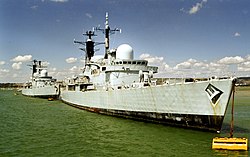Operational service
On 12 May 1992, Newcastle deployed with the Orient '92 group HMS Invincible, HMS Boxer, HMS Norfolk and RFA Olwen to the Far East. During this time she partook in Joint Exercises in the Malacca Straits and carried out diplomatic visits to The Seychelles, Singapore, Hong Kong, Japan and the Philippines. She returned on 27 November 1992. In 1993, Newcastle undertook exercises in the northern fjords of Norway during Exercise Battle Griffin '93 and undertook Fleet Ready Escort duties. On 8 September 1993 she deployed for Southlant duties as Falkland Islands Guardship. En route, she called in at Abidjan, Cote d'Ivoire and spent Christmas and New Year in and around the Falkland Island patrol areas. She was relieved by the Leander Class Frigate HMS Scylla and returned to UK via the Patagonian Canals, calling in at Valparaiso, Callao and Port of Spain with a fuelling stop at Ponta Delgado before returning to Portsmouth on 8 April 1994. The rest of 1994 was spent in maintenance and navigation training. She paid off into refit in Rosyth in July 1995. On her way north, Newcastle made a final goodwill visit of this commission to the city of her name.
In November 1997, Newcastle made her way to the Caribbean to assume duties as West Indies guard ship. This deployment was concerned primarily with counter narcotics operations and saw the ship embark a US Coast Guard Law Enforcement Detachment (LEDET) under the command of US Coast Guard District 7 in Miami. Throughout the eight months of the "WIGS" deployment Newcastle rendered assistance to the Governor and people of the British Overseas Territory of Montserrat following a devastating volcanic eruption. [Note 1] Newcastle re-entered Portsmouth Naval Base on 10 July 1998.
In 1999, Newcastle escorted the aircraft carrier Invincible during the Kosovo War, in which Invincible launched attacks on Serbian targets. Newcastle took part in six-month Atlantic Patrol Deployment in 2002. During this deployment, she visited Sierra Leone to display the continuing UK commitment to that country. Despite speculation that four Type 42s would be either decommissioned or mothballed, Newcastle deployed to the Mediterranean in January 2004 for a 7-month tour of duty.
This page is based on this
Wikipedia article Text is available under the
CC BY-SA 4.0 license; additional terms may apply.
Images, videos and audio are available under their respective licenses.

